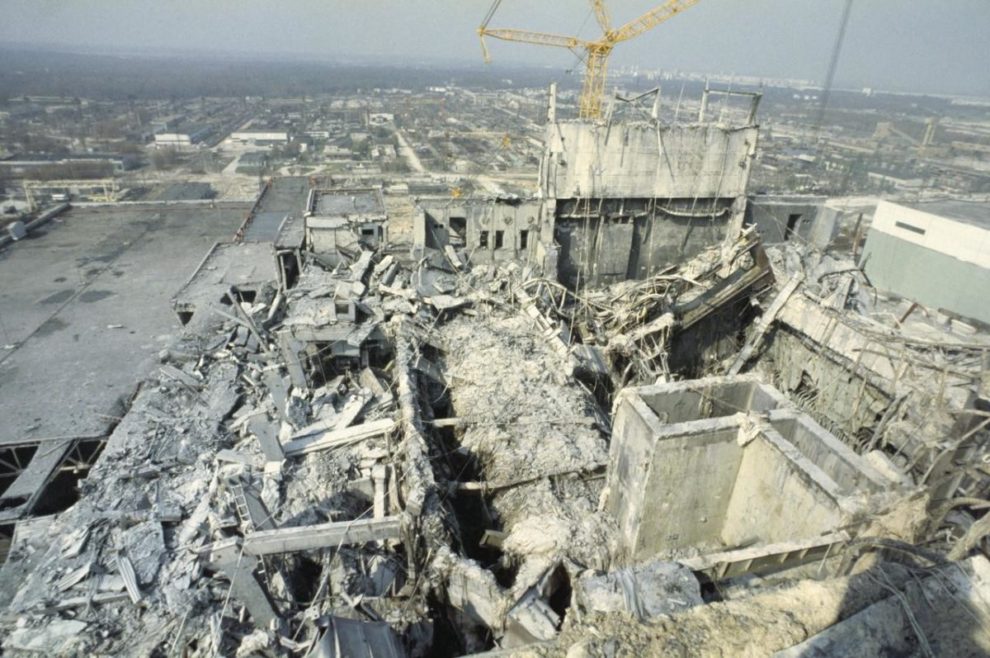The First Photos of Chernobyl After The Nuclear Disaster, April 26, 1986

Above is Ukrainian photographer Igor Kostin’s grainy picture taken on the morning of April 26 1986 of the Soviet-era Chernobyl nuclear reactor. Within hours of the Chernobyl explosion, Kostin (27 December 1936 – 9 June 2015) and four other photographers flew over the nuclear power plant in a helicopter. The high radiation ruined all of his pictures except for one.
h/t: flashbak
Kostin’s photograph of Chernobyl survived the intense radiation.

A series of explosions had destroyed Chernobyl’s reactor No. 4. Hundreds of staff and firefighters tackled a blaze that burned for 10 days and sent a plume of radiation around the world. More than 50 reactor and emergency workers were killed in the immediate aftermath.
May 1986: A helicopter decontaminates the disaster site.

Kostin continued to record stories of those affected by the disaster, including pictures of gigantic plants and malformed animals in the 30-mile exclusion zone. His 1998 photograph of a child in a special school for abandoned children in Belarus was nicknamed ‘the Chernobyl Child’. The child was adopted by a British family and endured many operations.
May 1986: In a 30km no-go zone around the reactor, liquidators measured radiation levels in fields using radiation counters. Their anti-chemical warfare suits offer no protection against radioactivity.

Donate to support the Ukrainian Red Cross to help civilians in this difficult time for Ukraine. You can donate right now:
Donate page on the URCS website: redcross.org.ua/donate
iRaiser platform donate.redcrossredcrescent.org/ua/donate
(in Ukraine) SMS to the number 88033 Vodafone. The cost of a charity SMS is UAH 20.
🇺🇦 ❤️
May 1986: Following the evacuation of around 15,000 residents from Chernobyl on 5 May, 1986, liquidators washed radioactive dust off buildings and streets using “bourda” (molasses).

June 1986: Fish dead from radiation flounder by an artificial lake used to cool the Chernobyl plant that was used to cool the turbines.

September 1986: Liquidators clean the roof of reactor 3.

October 1986: Reactor 3


November 1986: Hans Blix (centre), director of the International Atomic Energy Agency, watches a video detailing the clean-up operations with members of a government commission.

January 1987: In Moscow, a liquidator is checked over by a after an operation

August 1987: Kopachi, a village 7km from the Chernobyl reactor, is flattened and buried

Summer 1987: Gigantism in plants

1988: Relatives at the funeral of radiation expert “roof cat” Alexander Goureïev, a liquidator who cleared the roof of reactor 3.

1988: ‘The Chernobyl Child’

1988: Jitomir, Ukraine.

August 1989: Demonstrations in Kyiv demand the public sees secret Chernobyl documents. “We demand a Nuremburg trial for Chernobyl.”

December 1989: Contaminated apples

1992: A villager in the no-go area continues to live off the land.

1992: The evacuated city of Pripyat, no longer home to the 47,000 inhabitants. it cannot be inhabited for another 24,000 years.

Summer 1991: Kostin reflected in the window of a control post at the entrance to Pripyat

12 October 1991: After a second explosion at the Chernobyl nuclear power station on 11 October, 1991 in the turbine hall of reactor 2.

June 1992: Kostin in the machine room under reactor 4


